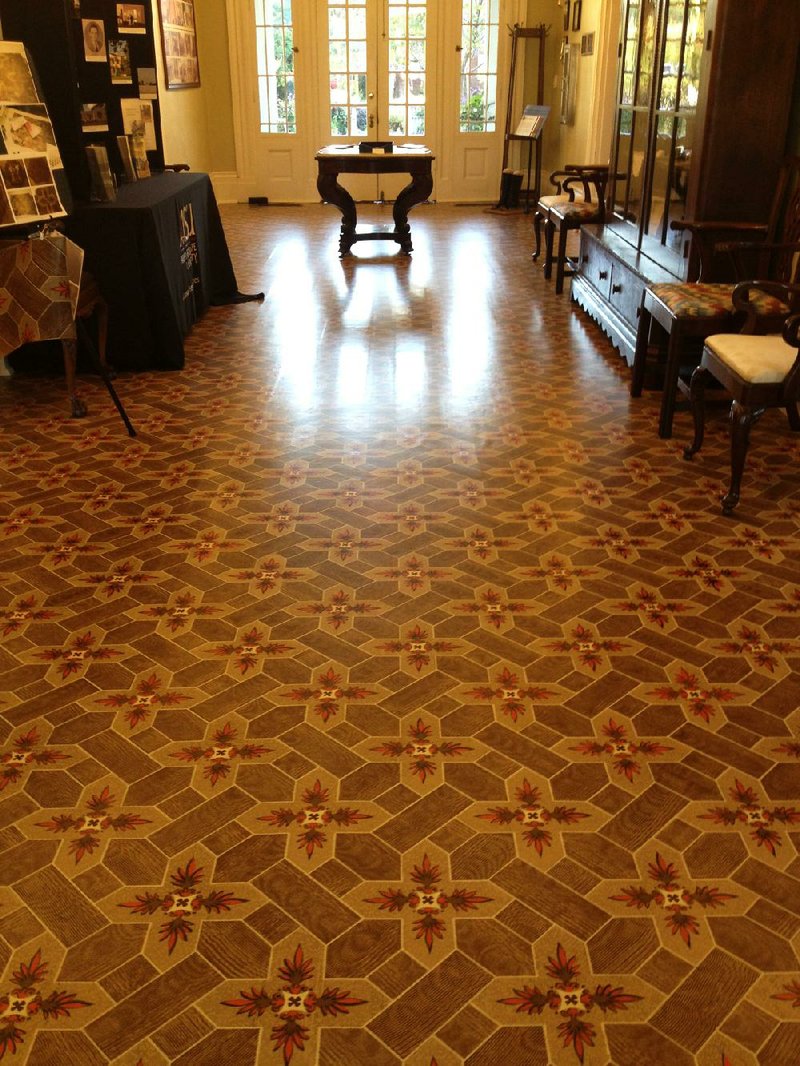LITTLE ROCK — Quite the floor show was held recently during an evening reception at the downtown Little Rock antebellum home Curran Hall, which serves as the city of Little Rock’s Visitor Information Center.
Libations were flowing but there was no singing or dancing.
Instead, all eyes were on the central hallway of the historic building at 615 E. Capitol Ave. - and they were all cast downward.
The main attraction? The floor, or more precisely, a new floor cloth - a 12-by-42-foot stretch of muslin covered with myriad coats of paint and protected with layers of clear varnish painstakingly designed and painted to replicate an 1850s floor covering.
Craftsman Riley May of Columbia, Tenn., who spent months creating the floor cloth, was the featured guest at the October session of the Quapaw Quarter Association’s monthly “Preservation Conversations” program.
A 300-POUND PROJECT
May began working on the Curran Hall project at the start of the year and delivered the completed cloth in September. The 504-square-foot piece weighs a hefty 300 pounds and was a challenging canvas for the decorative artist.
“We began talking about this project two years ago,” says Carolyn Newbern, president of the Little Rock Visitor Foundation, a private nonprofit that supports the center, which is operated by the Little Rock Advertising and Promotion Commission and managed by the Quapaw Quarter Association, a private, nonprofit historic preservation organization. The association manages Curran Hall, the visitor information center and the mayor’s reception hall within.
The center is home to exhibits about the history of Little Rock and furnished as mid-19th-century Little Rock homes may have been. The striking floor cloth, which runs the length of the center’s entryway, helps to complete the scene.
The Curran Hall floor cloth project was led by the Visitor Foundation.
When the city acquired Curran Hall in 1997, the foundation’s emphasis was on saving the structure, but once restoration was complete, efforts switched to furnishing the antebellum home with decor and furnishings in the American Empire style.
“When we got to the floor in the central hallway, it was splintered, tongue and groove, and uneven,” Newbern says.
“We wondered, ‘How do we replace it? What could we put on top? A carpet? Then what do we do when red wine gets spilled on it?’”
Newbern - who had seen one of May’s reproduction floor cloths at the Carnton Plantation in Franklin, Tenn. - contacted him about creating a floor cloth for Curran Hall.
May is a third-generation craftsman and owner of a restoration company that specializes in stenciling, gilding, faux graining and marbleizing. In recent years, he started manufacturing floor cloths.
The design of the Curran Hall floor cloth is based on a fragment of an original floor cloth discovered during a 1970s restoration project in the 1850 Soulesbury Institute-Glenn House in Batesville. That fragile fragment is now part of a collection of historic house remnants housed at the Old State House.
Becky Witsell of Little Rock, a preservationist who specializes in conserving and re-creating historic finishes including stenciling and faux wood-grain finishes, uncovered the section of floor cloth while working under a staircase in the Batesville structure. She added the scrap to a collection of historic decorative fabric and wallpaper samples she and her husband, Charles, an architect who specializes in historic preservation, amassed over decades and later donated to the Old State House.
WHAT’S THE DIRT?
Floor cloths, easy to clean with soap and water, were once commonly placed in foyers, reception halls or central hallways to protect the rest of a home, its furnishings and carpets from mud and grime tracked in from the street.
“Floor cloths were invented as a way to make housekeeping easier,” Witsell explains.
“It was an investment but it was a good investment - in a home like Curran Hall with its central hallway, it helped protect the very expensive carpets which would have been found in the other rooms beyond that.”
The earliest floor cloths in this country were used by Colonists and handmade and painted on sail cloths. By 1850, floor cloths had become widely popular and were made on heavy burlap or hemp. Later examples were made with block prints and modern ones are still created on cotton duck or heavyweight canvas.
The colors in historic floor cloths were usually vibrant because indoor lighting was poor. By 1900, with the advent of linoleum, floor cloths and oilcloths were waning in popularity. The objects haven’t disappeared completely from favor, however. These days, floor cloths are created by craftsmen working on commission for restoration projects or by amateurs as do-it-yourself projects. And they can be found for sale by artists. A quick search of the online arts and crafts marketplace at www.Etsy.com shows dozens of artists selling small, hand-painted floor cloths ranging in price from $9 to $1,000.
SETTING THE SCENE
The Curran Hall floor cloth, paid for with the support of the Little Rock Advertising and Promotion Commission, cost $8,500. There were also additional costs for installing and finishing threshold plates crafted from aged cypress to match the historic home, preparing and stabilizing the wooden floor for the floor cloth, and researching and documenting the historic fragment upon which the new floor cloth was based.
May and those who commission floor cloths believe they are worth the expense and effort.
“They really enhance the furnishings of a home and are hygienic and cleaner than carpets and are pretty in appearance,” he said.
While original floor cloths are rare to find still in place, they can survive if properly maintained with periodic revarnishing and retouching as needed. Melrose Plantation in Natchez, Miss., has one that has been in place for 150 years.
HomeStyle, Pages 41 on 11/24/2012

